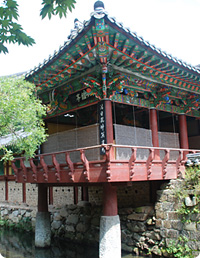PACKAGE
Seoul Combination 5 days
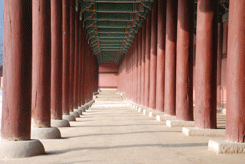
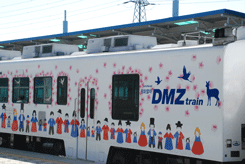
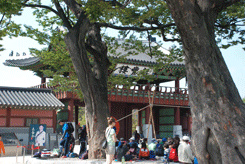
Tour Highlights
- Gyeongbokgung Palace
- National Folk Museum of Korea
- Jogyesa Temple
- Insadong
- Namdaemun Market
- Mangbaedan Altar
- Freedom Bridge
- Locomotive Engine
- Peace Stones
- Peace Bell
- The 3rd Tunnel
- Dora Observatory
- Dorasan Station
- Hwaseong Fortress
- Korean Folk Village
Click on the days to access the programs quick
| Days | Visits and Activities | Distance |
| Day 1 | Arrive Seoul | 60km |
| Day 2 | Seoul | |
| Day 3 | Seoul - DMZ - Seoul | 140km |
| Day 4 | Seoul - Suwon - Yongin - Seoul | 90km |
| Day 5 | Departure | 60km |
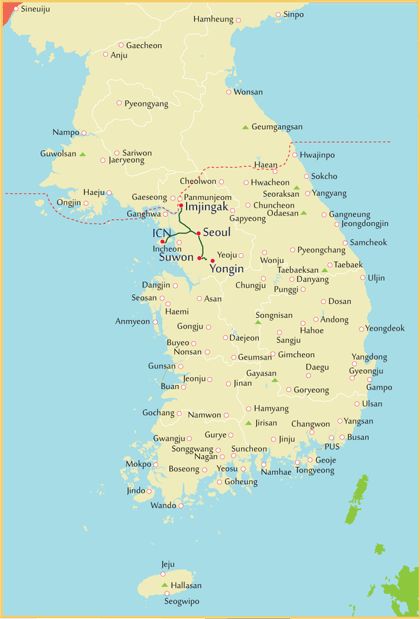 Day 1 Arrive Seoul (- - -) 60km
Day 1 Arrive Seoul (- - -) 60kmTouching down at Incheon International Airport places you in the heart of Korea. After you clear Passport and Customs control, you will be welcomed by the tour guide and then transferred to your hotel.
Day 2 Seoul (B)
Your exploration this morning begins with a driving tour of Seoul, featuring sites such as Seoul Plaza, City Hall, Cheonggye Square and pedestrian-friendly Gwanghwamun Plaza that is hemmed in on three sides by rushing traffic. The plaza is lined on each side with 365m long streamlets, two centimeters deep and one meter across, the stone bed of the plaza's east side waterway engraved with important events in chronological order from 1392 to 2008.
Standing high on a stone pillar is a statue of Yi Sunsin who had engaged in twenty-three naval battles and emerged victorious in all of them during the Hideyoshi invasion (1592-1598). King Sejong who propagated the Korean alphabet in the 15th century is also honored with prominent statue. On August 16, 2014, Pope Francis celebrated Mass in this plaza to beatify 124 Korean martyrs. Near the southwest corner of the plaza is Korea's Kilometer Zero, marking the distances to 64 cities around the world, including Seoul's antipode, Montevideo, Uruguay, 19,606km.
Step back in time to when life was gracefully slow and discover Gyeongbokgung Palace, a particularly charming spot that represents a colorful and turbulent side of the capital's 500-year history. Depending on timing, you may witness the Royal Guard Changing Ceremony featuring parade, password verification, duty shift and patrolling the gate. Accompanied by a court band with its colorful costumes and royal flags, the ceremony is performed daily basis at 10:00 and 14:00 except Tuesdays, although it is cancelled in case of rain or extremely hot or cold weather.
Up from the gates is a spacious stone-paved courtyard that is fully enclosed by wooden cloisters, and at the center of which runs three footpaths through two rows of rank stones, indicating the positions of the officials with the highest rank being closer to the hall.
Standing majestically on top of a two-tiered stone platform that is lined with detailed balustrades is Geunjeongjeon Hall, where the king formally granted audiences to his officials, gave declarations of national importance, presided over large official functions, and greeted foreign envoys and ambassadors. Check out the royal throne and a large painting, depicting sun, moon, five peaks, streams and pine trees, which was the crucial signifier of the king. And up in the center of the ceiling, the bright golden dragons in bold relief indicate the presence of the king.
At the back of the throne hall is a group of court offices. Displayed in front of the King's official quarters is sundial, conceived in order to catch the shadow of the sun, which tells time and 24 periods of seasonal change from the winter solstice to the summer solstice.
Sitting on the island in the rectangular lake is Gyeonghoeru. Supported by 48 square and cylindrical massive stone pillars representing the idea of Yin and Yang, this magnificent pavilion was used for many purposes ranging from receptions to national examinations.
Gangnyeongjeon is the king's sleeping and living quarters while Gyotaejeon is the queen's domain containing a number of halls. The noted feature of these main buildings is an absence of a top roof ridge.
Amisan Garden, landscaped with four hexagonal chimneys in orange bricks, is seldom noticed by the hurried visitors. Jagyeongjeon is the queen dowager's residence. Although less colorful, it is worth noting the wall, adorned with floral designs and the chimneys with ten longevity symbols.
Hyangwonjeong features a small pond with a manmade islet that supports a beautiful two-story pavilion. Behind this serene garden is Geoncheonggung, where the king and queen could relax in peace and quiet. It was here that the first electric lights in the country were installed in 1887 after 8 years of Thomas Edison's invention and a tragic chapter in Korea's history was recorded when empress Myeongseong was assassinated by the sword-bearing Japanese assassins in the early morning of 8 October 1895, allegedly under orders from Miura Goro.
Your visit to the National Folk Museum of Korea will familiarize you with wealthy culture of this friendly and picturesque nation. It is an excellent facility to illustrate the history of traditional life of the Korean people from the prehistoric age to the Joseon dynasty. The permanent exhibition features life and work, costumes and ornaments, handicrafts and technology, educations, living quarters, dietary life, oriental medicine, performing arts and games, beliefs and rituals, and socio cultural life.
Squeeze in a stop at Jogyesa, the head temple of Jogyejong the principal sect of Korean Buddhism, emphasizing the Zen orthodox, meditation tradition and the purity of monastic celibacy. The temple does not give off the solemn and traditional air of the other temples located deep in the mountains, but when you enter the temple the frenzy of the city start disappearing. The Main Worship Hall holds triad Buddhas, Sakyamuni, Amitabha and Bhaisajyaraja. The figure in the center is Sakyamuni Buddha who has overcome greed, hatred and delusion. While here it is worth noting the 500 year old lacebark pine and 400 year old locust tree that still grace the property.
Insadong, at one time the center of traditional Korean art and antiques, features a mixture of historical and modern atmosphere representing the cultural glimpse of the nation. Clustered along the main street and alleys are lined with street vendors, wooden tea houses, restaurants and numerous galleries and shops dealing in antiques, oriental art supplies, and modern Korean art of all types and styles. Soak in the paintings, upscale artworks, antiques and potteries while you can. Get lucky and you just might meet the artist themselves. It can be plenty of fun walking on the main street, but you venture into the hidden alleys that do spring some unexpected surprises. While here, you may want to buy some souvenirs or simply wander and browse at leisure admiring cultural ambience.
Drive past Cheonggyecheon Stream. After the Korean War (1950-1953), more people migrated into Seoul to make their living and settled down along the stream in shabby makeshift houses. The accompanying trash and waste, and deteriorating conditions resulted in an eyesore for the city. The stream was covered with layers of concrete in the mid 1950s and roadway until the massive urban renewal project freed it in 2005. Today, a 5.8km creek tumbles gently through downtown Seoul, providing a much needed source of peace and relaxation for the citizens of this fast-paced city. You may have a chance to view the sculpture standing tall at the head of the stream on a small plaza. Created by Dutch artist Coosje Van Bruggen and Swedish artist Claes Oldenburg, a shell rising upward like pagoda symbolizes new life.
You will tour the centuries-old Namdaemun Market brimming with well over 11,000 shops selling anything you can imagine. One of the most colorful aspects of the market is an endless sprawl of street-vendor stalls that setup in the alleys and walkways between the buildings. The market is seriously crowded, so be prepared to get bumped around. A fantastic place to haggle over the price to get the best deal on something you want or simply admire the vibrancy of this massive market.
At the western entrance of the market in the middle of a traffic circle stands Sungnyemun. It is a formidable and iconic construct that served as the southern gate of the wall that surrounded Seoul during the period of the Joseon Dynasty.
Day 3 Seoul - DMZ - Seoul (B) 140km
Please note that the DMZ is a politically sensitive area, and is therefore not always open to tourists.
In the event that the area cannot be visited, alternate sightseeing will be arranged.
The 3rd Tunnel tour
Rules and Regulations |
Your touring today will be private today until you reach Imjingak, at which time you will board a bus with other tourists as private tours of the tunnel and DMZ area are not allowed. Your private tour guide will remain with you throughout the day. On the way, you will drive the highway that is lined on one side with barbed wire and frequent guard stations spaced along the river that makes up part of the border. Imjingak is the furthest north point in the area than you can go freely, and a park with an array of monuments and statues that speak to the Korean War (1950-1953). One such monument is Mangbaedan, a memorial site where displaced North Koreans pray for their ancestors. Near Mangbaedan is the Freedom Bridge, and was an important site where 12,773 prisoners of war returned to freedom. This short, sturdy wooden structure ends at a barricade, which embodies the North. The altar and the bridge now serve as places of remembrance for displaced families, and the millions of bright colored ribbons tied to the fence have messages of hope, dreams and wishes for unification between South and North Korea.
You can also see a derelict locomotive engine shot full of bullet holes and its bent wheels - not particularly special in any way other than it shows the destruction of war. Having been left in the DMZ since bombs derailed it during the Korean War; it was cleaned up and moved here in 2009. There is a collection of stones from 86 battlefields in 64 countries known as the Peace Stones that have witnessed suffering and grief of war.
Then, you board a bus to continue with other tourists on to the Demilitarized Zone which straddles the South and North Korean border. A 4km wide buffer of land stretches the breadth of the Korean peninsula. Although an Armistice came into effect in July 1953, the two Koreas are still technically in an active state of war. Tensions between the two countries remain high, and the border is patrolled by thousands of troops on both sides.
DMZ has strict security measures, passports need to be cleared at the Unification Bridge, the first control line with sentries and photo opportunities will be limited.
The tour stops at DMZ Theater and Exhibition Hall for a short video including old film that takes you back in time to the signing of the armistice and the creation of the DMZ. Displayed in the exhibition hall are model of soldiers digging the tunnel, equipment used by the North, model of Panmunjeom (or Joint Security Area), a timeline of major North Korean provocations over the South since 1950, and photographs of the historical events about Korea's division.
The 3rd tunnel is one of the four infiltration tunnels dug by the North that have been discovered by the South on October 17, 1978. It is a 1,635m long, 2m high and 2m wide, and could have accommodated 30,000 soldiers per hour in what was apparently designed for a surprise attack on Seoul. The tunnel runs through bedrock at a depth of about 73m below ground; 435m of which are found in the South over the Military Demarcation Line. It is designed at a three thousandth angle with northern side lower than southern side, so that water does not stagnate inside tunnel. You can clearly see the drill marks for dynamite all pointing toward the South. This finding, along with other clues, clearly affirmed their construction.
The tunnel, which is now well guarded, though it is a busy tourist site, where you enter either by walking down a long steep incline and of course up again or via a sled on rails that contains a driver in up to groups of thirty or more based on reservation. After ducking and crouching your way 265m through the tunnel, you will reach one of the cement walls with iron door near the Military Demarcation Line that will prevent you from going any further north and where you peep through a small window at a barricade, just to see another barricade in the distance.
Situated on top of Mount Dora, Dora Observatory looks across the Demilitarized Zone with a South Korean flag in Daeseong-dong near Panmunjeom and a North Korean propaganda village, Gijeong-dong where 270kg (30m x 14m) North Korean flag hangs on a 160m-tall jamming tower and North Korean city of Gaeseong. In 1981, the South Korean government built a 99.8m-tall flagpole with a 130kg (18m x 12m) South Korean Flag. The North Korean government responded by building what was then the tallest flagpole in the world at 160m, in what some have called the "Flagpole war". The flagpole was superseded as the world's tallest, following the construction of the flagpole in Baku's National Flag Square at 162m. Both flagpoles were topped in 2011 by the Dusanbe Flagpole in Tajikistan at 165m.
You will also tour the Dorasan Station, the last railway station in South Korea before the North Korean border. This station drew world attention when President Bush visited here in February 2002. On December 11, 2007, freight trains began traveling north past this station into North Korea, however, on December 1, 2008, the North Korean government closed the border crossing. The station is heavily guarded and signs are up showing the future destination of Pyeongyang in North Korea. The milepost "Seoul 56km/Pyeongyang 205km" still stands from the time when trains could still cross past this station and into North Korea.
Day 4 Seoul - Suwon -Yongin - Seoul (B) 90km
Depart on an excursion to Suwon to explore UNESCO World Heritage site of Hwaseong Fortress from the 18th century. Though it is relatively small in scale, it is well acknowledged as the best structure of its kind ever built in Korea. A 5.74km-long fortress enclosing both flatland and hilly terrain is parapeted with crenels and merlons and highlighted by four main gates and well over 50 structures including temporary palace where the king sought refuge during war and found rest during times of peace. A walk through the whole fortress could take several hours but it is well worth making a short walking tour to enjoy the splendor of the fortress, including the Korea's largest Janganmun Gate.
You will then experience the heritage of the Korean people and soak up the local culture. A village entrance is marked by an eye-catching stone tower topped by a symbolic stone serving as fertility and protective totem, where people write a wish on the paper and tie to the ropes. Korean Folk Village is a functioning community displaying the diversity of Korean lifestyle and culture of several centuries ago. On entering the village, you are greeted by goofy looking group of wooden Jangseung signifying village boundary and preventing bad luck.
The village holds a wide assortment of residential structures from the straw-thatched cottages of commoners to the 99-room mansions of the noble class as well as governor's office. There are many workshops where the real artisans and craftsmen dressed in traditional costumes ply their trades, demonstrating centuries-old craftsmanship in the art of pottery, pyrography, bamboo craft, Korean paper, brassware, and many more. While strolling past the houses and workshops one by one, you will get the feeling of walking through time in an ancient village.
Depending on timing, enjoy farmer's music and dance, which has been the beloved form of entertainment of Korean people, bearing testimony to the gregarious character of Korean fun-making and festivity. Jultagi or acrobatics on a tightrope is something you cannot miss. The rope walker executes a variety of acrobatic feats on the rope, along with jokes, mimicry, or songs, while a clown engages the tightrope walker in joking banter, and a team of musicians plays music to accompany the entertainment.
You will experience some of long-observed seasonal customs, beliefs, folk games or plays that have been comprehensively reflected the daily life of the Korean people. A traditional wedding ceremony is also performed on a daily basis, although it may no longer be explicitly followed.
A traditional marketplace offers the exotic flavors of Korean cuisine from different regions. Shops stock a variety of handicrafts and souvenirs, many of which were made on the premises. With all these features combined, the tour offers a fascinating insight into the unique Korean lifestyle of the days gone by.
Day 5 Departure (B) 60km
After this wonderful trip exploring Korea and with time to reflect on your surprise in your experience, you will return to the airport in time for your flight. By boarding, you are already high above Incheon heading for home.





